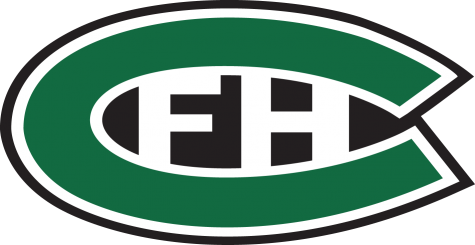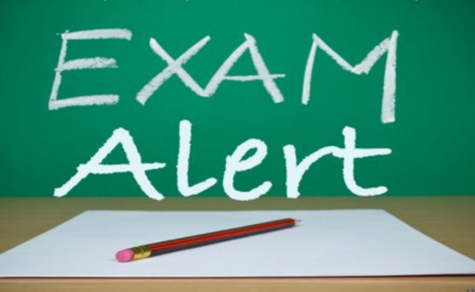Typing in codes and working out sequences

Teacher Joseph Smith stands in front of a whiteboard in room 225, the computer lab that stands next to his classroom. The students watch as he carefully explains the assignment they are to complete within the next two days. When he is finished, the class turns to their computers and each student begins typing out sequences of numbers and letters that seem to make no sense at all. Unless, of course, you are part of the AP computer science class.
“It’s completely different, but really good,” Smith said. “You could take this a long ways.”
Smith believes there are a lot of benefits to taking the course, specifically due to his teaching methods. He says that because he really makes his students think about a problem, it can help them become better problem solvers and logic thinkers. There’s a large demand for high quality programming individuals in the real world, which could help anyone with almost any job.
“I think that many students could benefit from it,” Smith said. “I don’t know if everyone should sign up for it, but I would like everyone to sign up for it.”
Senior Fatima Haidar agreed with Smith on the pluses of taking the class.
“Learning the stuff and the programming aside, the class itself really helps build logic, which I wasn’t expecting,” Haidar said. “The first day I regretted [joining the class] and I didn’t know what Java was or anything like that. But what I like most is that I’ve learned a more logical approach to problem solving.”
Haidar explained what drew her to taking the class.
“It interested me because it’s something I’ve never done before, and I don’t like math always being the same,” Haidar said. “So after [taking] Stats last year, I thought I would try this.”
Smith determined that his favorite part of teaching this class is how it differs from a math class. He enjoys the opportunity to teach different material, as well as sending his students off to try the assignment. He believes that the best way to get the most learning is by struggling and figuring out how to do the work. There’s a lot of student learning going on.
“I feel it’s a more casual laidback course than, say, a math class,” Smith said.
Junior Ryan Hilbert stated that his favorite part is more than completing the assignments.
“My favorite part of the class is when I get all my work done,” Hilbert said. “Then it’s just you and a bunch of other computer nerds, and you just play videogames for thirty minutes.”
Junior Brooke Bacigal’s favorite part of the class is not just the students, but the teacher as well.
“Mr.Smith’s sass really brightens up my day,” she said.
Despite how much he enjoys teaching the class, Smith does wish that the scheduling was a bit different. He believes that the class might run a bit better if it were scheduled in the way that Ms.Schrotenboer runs the creative writing class. He says that because there are some kids that do not need his help with the assignments, it is not necessary for the class to meet every day.
“I would love to meet two, three days a week, and then have two lab days,” Smith said. “If you wanna be here and program, I’m here.”
While this class is similar to others in the aspect of a usual curriculum, the general mood of the classroom is something else. Smith says that the atmosphere is different, mainly due to the crowd he’s dealing with. The nature of the course, according to him, causes more boys to sign up than girls.
“This year I have six girls, which is a lot for me, [and] I’m super excited about [it],” Smith said.
Smith also stated that there have been other teachers who will come by and see a different side of their students.
“[The other teachers] will go, ‘I’ve had that student in class and they’re nothing like that in my class’,” Smith said. “There’s this feeling of this is where they belong. That’s the sense that I get. That they feel more comfortable in this class because they like the material and they have the freedom to explore in a very educational setting.”
While the class consists of time consuming projects that require a large amount of focus, nobody seems to be complaining. According to Smith, there’s usually no problem.
“They’re normally pretty good about trying to solve a problem and staying on task,” Smith said.
Bacigal also expressed her feelings on the atmosphere of the room.
“It’s a lovely ambiance and sense of camaraderie enhanced by the glow of our computer screens,” she said.
Hilbert stated that it’s the teacher, not the subject, that makes the class enjoyable.
“Mr.Smith teaches it, which is awesome,” Hilbert said. “He’s got a really quirky personality and he interacts with the class a lot. I mean, he’s just a friendly dude so whenever we learn a lesson it’s just really chill and relaxing, not pressured or anything.”
Haidar agreed with Hilbert, saying that it’s really because of the teacher that she finds the class easier at times.
“He really knows his subject,” Haidar said. “That’s what makes him a good teacher.”
With all the technology in today’s world, there are a lot of careers in which computer programming is a necessity. Because of this, there is a large push from the computer science education community to make this class a requirement in order for students to graduate. Smith thinks that if someone takes the class, then they’ll have a better understanding of the way phones, tablets, and computers work.
“It’s no longer that these are the computer nerds that are going to sit behind the scenes,” Smith said. “I think that if you learn how to program, you understand the way technology works. And that’s a very important skill even if you choose to never program again in your life.”
Bacigal also commented on how much this class can help with any career.
“[My favorite part is] the real world application,” Bacigal said. “Everything you learn you immediately put into practice by having to write programs. A lot of classes teach you about things or even teach you how to do things but this class actually has you do them.”
Smith says that no matter what field you go into, you’ll be working with programmers and “you need to be able to communicate with them and have some sort of knowledge base of how they think and work.” He added that there’s a huge array of careers in which computer technology is involved. The medical field, according to Smith, uses a lot of programming in doing research. He also believes that this class is definitely doable.
Hilbert agreed with Smith, believing that everyone should give this class a chance.
“It’s a class every student should take, it’s really fun,” Hilbert said. “It’s not as nerdy as you think. Don’t blow it off.”
Smith agreed that this is definitely not a class you can mess around in.
“Don’t come into the class thinking you can just coast through,” Smith said. “There’s work to be done. But at the end of the day I think it can be very rewarding. It can be very optimistic with what you want to accomplish.”
Q&A with Joseph Smith
On the career choices for his students: “There’s always a couple kids who’ve never been involved in programming before, sign up for the course and think ‘I think I want to do something like this for a career. I think [that] is pretty cool.”
On his teaching methods: “I say somewhat frequently that I like to throw them out in deep water and hope that they learn how to swim.”
On the atmosphere of the class: “I feel that it’s an elective course. You’re choosing to be here; you could choose to be someplace else. Because of that I don’t teach it nearly as strict as a math class. So I think that their attitude is more positive because it’s their choice to be [here].”
On wanting to give his students more time to work on their programs: “There’s nothing more frustrating than working on something big, and having to stop because the bell rang. Because when you come back the next day, you’ve forgotten what you were doing.”
On what makes the class different from others: “I would guess it’s one of the most rewarding classes.”
On the class in general: “It’s weird, but it’s a great time. If you’re willing to put in the time and the effort, and not give up, and be willing to ask questions,and willing to talk to somebody and willing to ask for help, then it’s very achievable.”

Kendra is in her second year on staff. She is Online Manager of the TCT website, and has won a MIPA honorable mention award for an informative story. This...






























































































